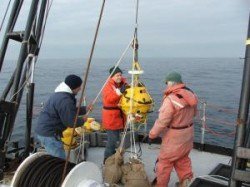Researchers To Develop Ocean Sanctuary ‘Noise Budget’ To Evaluate Potential Impact On Marine Life

Like sentinels at their posts, an array of buoys equipped with underwater microphones and other sensors will be on duty in the Stellwagen Bank National Marine Sanctuary off the coast of Massachusetts for the next 30 months, recording sounds from whales, fish, ships and other sources around the clock.
(From ScienceDaily) — NOAA marine mammal scientists will analyze the biological sounds to help develop a global monitoring network for ocean noise, an important step in effectively managing marine sanctuary resources and protecting endangered species like the North Atlantic right whale.
“The ocean is a noisy place,” said Sofie Van Parijs, marine mammal acoustician at NOAA’s Northeast Fisheries Science Center (NEFSC) and a project scientist. “It’s full of natural sounds and those from human activities, and there is substantial evidence that the level of man-made noise is rising. Marine mammals and many fishes are highly dependent on sound for communication, navigation, foraging and predator avoidance. We need to understand how these animals, especially endangered and protected species, are impacted by sounds from many sources to be able to better manage and protect these living resources.”
An ocean-observing system consisting of ten autonomous recording units will be deployed for periods of three months, each in different parts of the Sanctuary at different times of the year, to monitor low frequency sounds. The passive-acoustic buoys, moored to the ocean floor and fully submerged, continually record ocean sounds around the clock before they pop to the surface on command so the data can be retrieved and batteries refreshed.
The three-year project began in late December with funding from the National Oceanographic Partnership Program and a team of scientists and engineers from NOAA Fisheries, NOAA Sanctuaries, the Bioacoustic Research Program at Cornell University and Marine Acoustics, Inc. Van Parijs and NEFSC colleague Denise Risch, also a marine mammal bioacoustician, will analyze the biological sounds collected during the study, while Sanctuary scientists Leila Hatch, Michael Thompson and Dave Wiley will focus on the anthropogenic or human-produced sounds. Project leader Chris Clark of Cornell University and colleagues provide scientific guidance, hardware and software, and are working with Bill Ellison of Marine Acoustics, Inc. on modeling ocean noise propagation within the sanctuary.
The Gerry E. Studds Stellwagen Bank National Marine Sanctuary is an urban marine sanctuary located in close proximity to Boston and a densely populated coastal zone. The area has commercial fishing fleets, heavy vessel traffic, is frequented by marine mammals like endangered Northern right whales, and forms a critical feeding ground for endangered fin and humpback whales. It is also home to acoustically-sensitive marine animals like commercially important haddock and other fishes, sharks and sea turtles.
Van Parijs says the Sanctuary is a perfect place to build a case study that can provide a benchmark to scientifically evaluate the impacts and interactions between various human-produced sounds and acoustically-sensitive marine animals.
The abundance of endangered whales and human activities in the Sanctuary will help the team address many of the recommendations made by the National Research Council’s committee on the potential impacts of ambient noise in the ocean on marine mammals. The committee has cited the importance of sound in the lives of marine mammals, the potential for harm from excessive noise, and the lack of scientific data as to the amounts of noise introduced into the oceans by human activities and its potential impact on marine mammals.
“We need to ground-truth current sampling and analysis techniques and identify gaps that must be addressed prior to implementing a large-scale domestic or international monitoring program,” Van Parijs said. “The products of this project will be a suite of tools designed to be transferable for use in other ecological regions or sanctuaries along with an extensive database of sounds. This project is a first step toward a much larger goal of establishing a global passive acoustic monitoring network to measure ambient noise levels in a variety of locations.”
The first set of project buoys deployed in December were recently recovered from the northeast corner of the Sanctuary and were redeployed March 7 in the southwest corner, where endangered Northern right whales are congregating. The area is a primary nursing and feeding ground for the whales in the spring.
Ten similar buoys were used successfully in the Sanctuary in 2006 during a one-year pilot project in preparation for this study. This is the first project to record all types of sounds over a long time period in a relatively large area in an effort to characterize the marine acoustic environment and the health of an urbanized, highly productive ecosystem. One potential use of the information: scientists could track whale migration patterns and ship movements to help prevent collisions, a leading cause of whale mortality.
“Our goals are to map the low-frequency noise budget throughout the Sanctuary, identify and quantify the contributing sources of sounds, and determine whether or not these noises have the potential to impact endangered marine mammals and fishes,” said David Wiley, the Sanctuary’s research coordinator. “The results from this project will have local, national and international implications.”



